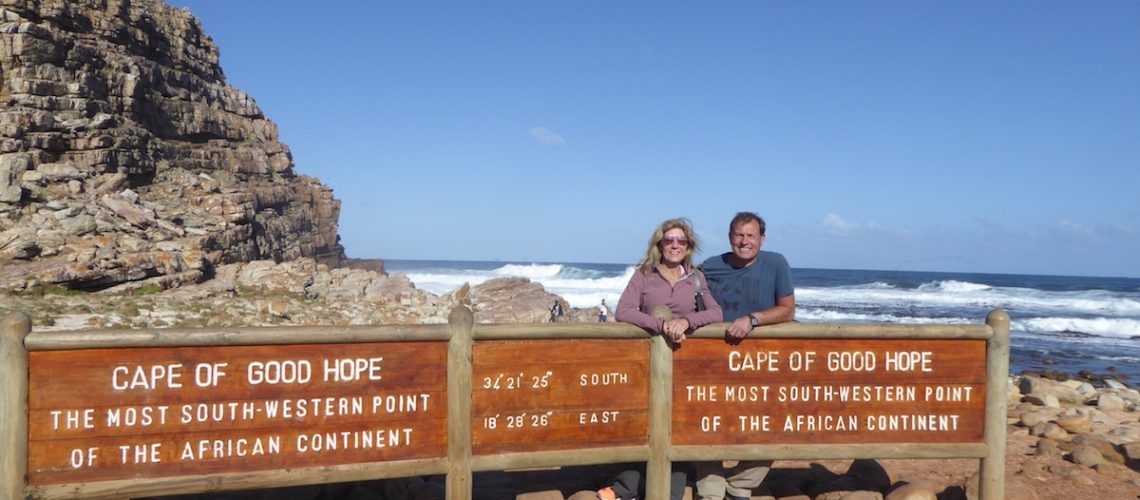While we were in Cape Town, one of the things I wanted to do personally, was go down to Cape Point. I’d also seen articles about the colony of African Penguins on the cape, and liked the idea of seeing them too.
We found a trip that would take us to Boulders Beach (to see the Penguins) and then on to Cape Point where we’d have time to explore a bit before returning back to Cape Town.
Before I go any further, our guide. A white Capetonian, who clearly loved his country and his city. He was not only passionate about them, but an absolute stickler for punctuality. If we ever got off the coach, he would reiterate five times how long we had, when the coach was leaving and our options for getting back if we missed it.
First a quick bit of history.
Portuguese explorer Bartolomeu Dias was the first to round the Cape Peninsula in 1488, naming it the “Cape of Storms”, for the notoriously bad weather, which can blow up quickly. Later, Vasco da Gama navigated the same route and sailed down the coast of Africa, successfully opening a new trading route for Europe with India and the Far East. King John II of Portugal later renamed it the “Cape of Good Hope” because of the great optimism engendered by the opening of this new sea route to India and the East.
‘The Point’ has been treated with respect by sailors since it was first sighted by Dias in 1488. By day, it was a landmark of great navigational value, By night, and in fog, it was a menace. Ships had to approach closely to obtain bearings and thereby were exposed to the dangers of Bellows Rock and Albatross Rock.
So the lighthouse was built. The original lighthouse was built in 1859 on Da Gama Peak, the summit of Cape Point, 238m above sea level. This made it very ineffective in mist, so a second lighthouse at 87 meters, Was built in 1914. This lighthouse is the most powerful on the South African coast. The old lighthouse still stands here and is now used as a centralized monitoring point for all the lighthouses in South Africa.
The other thing to note at this stage is that the Cape of Good Hope is NOT the most southerly point in Africa (it is the most south westerly one). That honour goes to Cape Agulhas, about 150km to the south east, and it is also in this area that the Atlantic and Indian oceans meet.
Anyway, back to the trip.
Another beautiful day, had South Africa and the Cape looking its finest. We travel out through the wealthy Cape Town suburbs to the coast, and drive down to Simon’s Town where Boulders Beach is located.
I had the impression that you could actually walk onto the beach with the little fellows, but actually it’s a long board walk that offers up a good view of African Penguins sunbathing on rocks, standing on the beach and jumping into the sea. What you do get though, is up close and personal contact with the smell. A combination of kelp and fish according to my nose…
These African penguins are only found on the coastlines of Southern Africa – (South Africa & Namibia). They are currently on the verge of extinction and as a result, the penguins are under the protection of the Cape Nature Conservation.
Strangely set in the midst of a residential area, it is one of the few sites where this vulnerable bird can be observed at close range in a protected natural environment. From just two breeding pairs in 1982, the colony has grown to about 3,000 birds in recent years.
If I’m honest Penguins don’t do very much. They are cute though, and make for some nice photos….
Back on the coach and onward.
As you progress further south along the Cape, the scenery gets increasingly dramatic, and more wild and rugged. Cliffs plunge into the sea, and the land is covered with “fynbos”.
(Fynbos is the term used for the vegetation all around Southern Africa, literally meaning “fine-leaved plants”, and it grows in a 100-to-200-km-wide coastal belt stretching from the West coast to Port Elizabeth on the Southeast coast, accounting for half of the surface area and 80% of the plant species.)
Before we get to the Cape Point National Park, we get a warning about baboons. How we should not eat near them, not take out any food, how we should just let them take what they want if they do approach us(!) etc. etc.
At the car park, there’s a short walk up some steps to the old lighthouse. We set off, and within a few meters we come across the baboons. Sitting in the path, on the hand rail, one eating a bag of potato chips he’s stolen from somewhere.
And indeed they are very brazen, trying to snatch peoples rucksacks and bags off their shoulders, and generally intimidating people just be their presence. It doesn’t stop some stupid people from leaving food for them though…
The rest of the trip is an opportunity to absorb and enjoy the dramatic scenery that the Cape and the route back up its western coast to Cape Town has to offer. For some more pictures see the Galleries….
